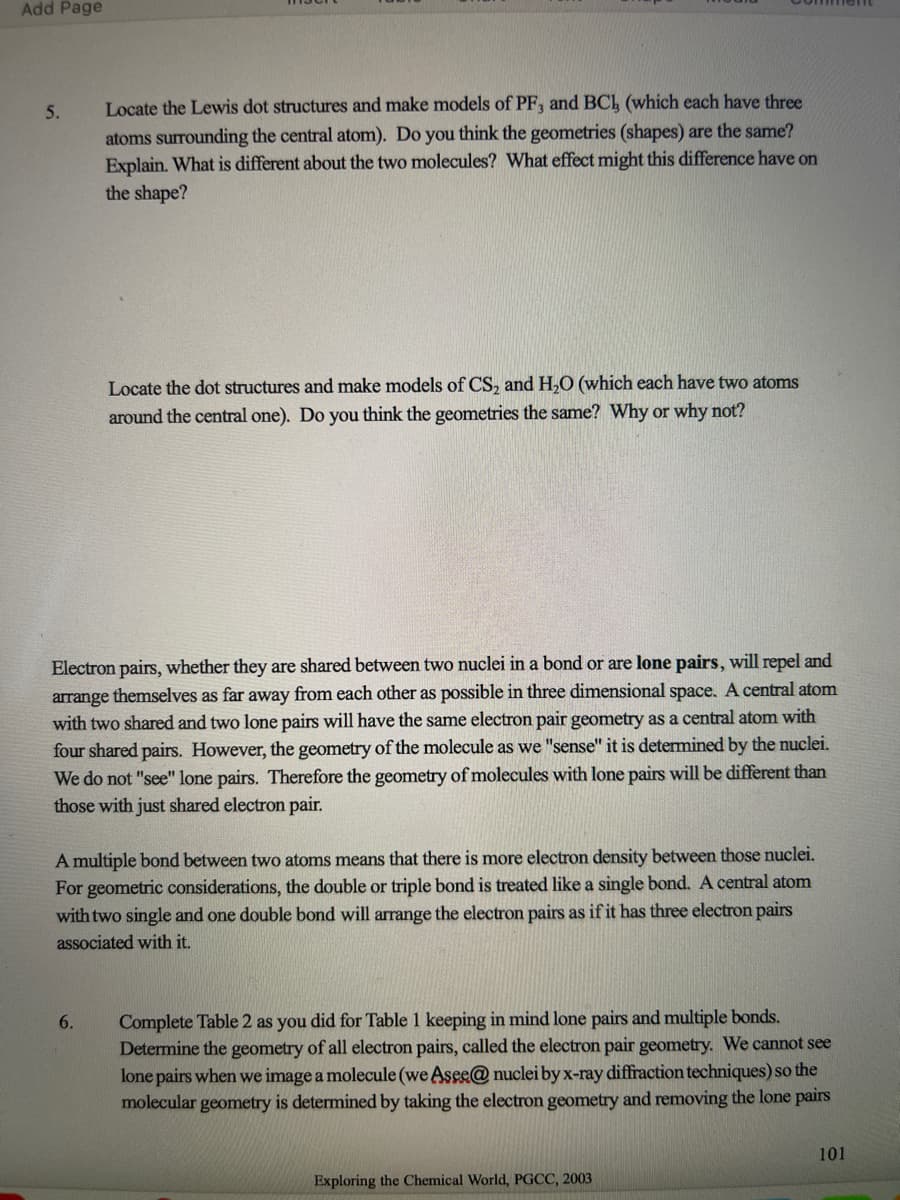Locate the Lewis dot structures and make models of PF, and BC, (which each have three atoms surounding the central atom). Do you think the geometries (shapes) are the same? Explain. What is different about the two molecules? What effect might this difference have on the shape? Locate the dot structures and make models of CS, and H,O (which each have two atoms around the central one). Do you think the geometries the same? Why or why not?
Locate the Lewis dot structures and make models of PF, and BC, (which each have three atoms surounding the central atom). Do you think the geometries (shapes) are the same? Explain. What is different about the two molecules? What effect might this difference have on the shape? Locate the dot structures and make models of CS, and H,O (which each have two atoms around the central one). Do you think the geometries the same? Why or why not?
Organic Chemistry: A Guided Inquiry
2nd Edition
ISBN:9780618974122
Author:Andrei Straumanis
Publisher:Andrei Straumanis
Chapter1: Bond Angles And Shape
Section: Chapter Questions
Problem 12CTQ: Consider the following flat drawing of methane (CH4) . a. What is HCH bond angle implied by this...
Related questions
Question

Transcribed Image Text:Add Page
5.
Locate the Lewis dot structures and make models of PF, and BCh (which each have three
atoms surrounding the central atom). Do you think the geometries (shapes) are the same?
Explain. What is different about the two molecules? What effect might this difference have on
the shape?
Locate the dot structures and make models of CS, and H,O (which each have two atoms
around the central one). Do you think the geometries the same? Why or why not?
Electron pairs, whether they are shared between two nuclei in a bond or are lone pairs, will repel and
arrange themselves as far away from each other as possible in three dimensional space. A central atom
with two shared and two lone pairs will have the same electron pair geometry as a central atom with
four shared pairs. However, the geometry of the molecule as we "sense" it is determined by the nuclei.
We do not "see" lone pairs. Therefore the geometry of molecules with lone pairs will be different than
those with just shared electron pair.
A multiple bond between two atoms means that there is more electron density between those nuclei.
For geometric considerations, the double or triple bond is treated like a single bond. A central atom
with two single and one double bond will arrange the electron pairs as if it has three electron pairs
associated with it.
Complete Table 2 as you did for Table 1 keeping in mind lone pairs and multiple bonds.
Determine the geometry of all electron pairs, called the electron pair geometry. We cannot see
lone pairs when we image a molecule (we Asee@ nuclei by x-ray diffraction techniques) so the
molecular geometry is determined by taking the electron geometry and removing the lone pairs
6.
101
Exploring the Chemical World, PGCC, 2003
Expert Solution
This question has been solved!
Explore an expertly crafted, step-by-step solution for a thorough understanding of key concepts.
Step by step
Solved in 3 steps with 4 images

Knowledge Booster
Learn more about
Need a deep-dive on the concept behind this application? Look no further. Learn more about this topic, chemistry and related others by exploring similar questions and additional content below.Recommended textbooks for you

Organic Chemistry: A Guided Inquiry
Chemistry
ISBN:
9780618974122
Author:
Andrei Straumanis
Publisher:
Cengage Learning

Principles of Modern Chemistry
Chemistry
ISBN:
9781305079113
Author:
David W. Oxtoby, H. Pat Gillis, Laurie J. Butler
Publisher:
Cengage Learning

Organic Chemistry: A Guided Inquiry
Chemistry
ISBN:
9780618974122
Author:
Andrei Straumanis
Publisher:
Cengage Learning

Principles of Modern Chemistry
Chemistry
ISBN:
9781305079113
Author:
David W. Oxtoby, H. Pat Gillis, Laurie J. Butler
Publisher:
Cengage Learning